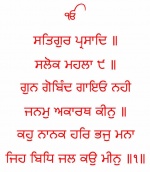Template:AOW182: Difference between revisions
Hari singh (talk | contribs) No edit summary |
Hari singh (talk | contribs) No edit summary |
||
| Line 3: | Line 3: | ||
{{pm|Image:Salok mahala 9ps.jpg|Salok Mahala 9}} | {{pm|Image:Salok mahala 9ps.jpg|Salok Mahala 9}} | ||
'''SALOK MAHALA 9''' are the [[salok]]s by the ninth [[Sikh Guru]], [[Guru Tegh Bahadur]] which form the concluding portion of the [[Guru Granth Sahib]]. They precede [[Guru Arjan|Guru Arjan's]] Mundavani and appear from page 1426 to 1429 of the Sikh holy Granth. This composition consists of 57 (Fifty Seven) saloks and consists just 4 pages of [[Gurbani]]. Each salok is a couplet consisting of 2 lines. This [[Bani]] was incorporated into the [[Guru Granth Sahib]] by [[Guru Gobind Singh]], the last human Guru of the Sikhs. As is commonly believed, they were composed by Guru Teg Bahadur while in the 'Kotwali' (prison) at [[Chandni Chowk]], [[Delhi]], before he achieved martyrdom. | '''SALOK MAHALA 9''' are the [[salok]]s by the ninth [[Sikh Guru]], [[Guru Tegh Bahadur]] which form the concluding portion of the [[Guru Granth Sahib]]. They precede [[Guru Arjan|Guru Arjan's]] Mundavani and appear from page 1426 to 1429 of the Sikh holy Granth. This composition consists of 57 (Fifty Seven) saloks and consists just 4 pages of [[Gurbani]]. | ||
Each salok is a couplet consisting of 2 lines. This [[Bani]] was incorporated into the [[Guru Granth Sahib]] by [[Guru Gobind Singh]], the last human Guru of the Sikhs. As is commonly believed, they were composed by Guru Teg Bahadur while in the 'Kotwali' (prison) at [[Chandni Chowk]], [[Delhi]], before he achieved martyrdom. | |||
These saloks form an important part of the epilogue when bringing to a close a reading of the [[Guru Granth Sahib]] on a religious or social occasion and should thus be the most familiar fragment of it, after the [[Japji Sahib]], the Sikhs' morning prayer. | These saloks form an important part of the epilogue when bringing to a close a reading of the [[Guru Granth Sahib]] on a religious or social occasion and should thus be the most familiar fragment of it, after the [[Japji Sahib]], the Sikhs' morning prayer. | ||
Salok, in [[Sanskrit]], signifies a verse of laudation or praise. In [[Hindi]] and [[Punjabi]], it has come to imply a couplet with a moral or devotional content. Its metrical form is the same as that of a [[doha]] or dohira, a rhymed couplet. Whether the slokas were written during the days just before Guru Tegh Bahadur's execution or earlier in his career as some say, their mood is certainly in consonance with the crisis of that time, when the Guru confronted the imperial might of the last great Mughal emperor, [[Aurangzeb]], to defend the freedom of religion and worship in [[India]] and gave his life for a cause which to him meant true commitment to God. {{aowf|Salok Mahala 9}} | Salok, in [[Sanskrit]], signifies a verse of laudation or praise. In [[Hindi]] and [[Punjabi]], it has come to imply a couplet with a moral or devotional content. <!----Its metrical form is the same as that of a [[doha]] or dohira, a rhymed couplet. Whether the slokas were written during the days just before Guru Tegh Bahadur's execution or earlier in his career as some say, their mood is certainly in consonance with the crisis of that time, when the Guru confronted the imperial might of the last great Mughal emperor, [[Aurangzeb]], to defend the freedom of religion and worship in [[India]] and gave his life for a cause which to him meant true commitment to God.---> {{aowf|Salok Mahala 9}} | ||
Revision as of 19:38, 1 November 2009
SALOK MAHALA 9 are the saloks by the ninth Sikh Guru, Guru Tegh Bahadur which form the concluding portion of the Guru Granth Sahib. They precede Guru Arjan's Mundavani and appear from page 1426 to 1429 of the Sikh holy Granth. This composition consists of 57 (Fifty Seven) saloks and consists just 4 pages of Gurbani.
Each salok is a couplet consisting of 2 lines. This Bani was incorporated into the Guru Granth Sahib by Guru Gobind Singh, the last human Guru of the Sikhs. As is commonly believed, they were composed by Guru Teg Bahadur while in the 'Kotwali' (prison) at Chandni Chowk, Delhi, before he achieved martyrdom.
These saloks form an important part of the epilogue when bringing to a close a reading of the Guru Granth Sahib on a religious or social occasion and should thus be the most familiar fragment of it, after the Japji Sahib, the Sikhs' morning prayer.
Salok, in Sanskrit, signifies a verse of laudation or praise. In Hindi and Punjabi, it has come to imply a couplet with a moral or devotional content. .....More

